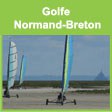5.4 Golfe Normand-Breton

 Site description
Site description
The Golfe Normand-Breton case study site is a large marine area in the west part of the Channel including French and Channel islands marine waters.
This area of over 11 000 km² comprises numerous marine protected areas with Ramsar, Natura 2000 sites, French designations sites and a proposed marine nature park on French waters.
Covering the greater part of the case study area, subtidal muds, sands, and gravels are home to a rich variety of habitats, flora and fauna. Intertidal marine habitats, composed of sandy or rocky foreshores, saltmarshes or biogenic reefs, remain very important because they supply a host of ecological functions essential to the life cycle of marine species.
This area is characterised by small to medium towns and villages with economies reliant to a significant extent on shellfish farming, tourism and leisure, commercial fishing, agriculture, nuclear power and fuel reprocessing industries, aggregates extraction and, in the future, offshore renewables.
[ Find out more about the case study site ... ]
The Norman-Breton Gulf is a proposed French Marine Protected Area. New elements are needed to feed the reflexion about the management of this large area.
Focus of study
Two main goals for the evaluation were identified: to provide an initial diagnosis of the marine ecosystem service and to anticipate future changes particularly in terms of ensuring continued participation and dealing with future conflicts.
[ Find out more about the focus of study ... ]
Key stakeholders and their involvement
The case study was led by the French Marine Protected Area management team with the participation of about twenty local stakeholders from state services, fisheries and shellfish farming representatives, recreational groups, industries (Marines renewable and extraction), Marine Protected Area managers. These stakeholders were consulted all along the scenario exercise.
[ Find out more about key stakeholders and their involvement ... ]
Approach for Ecosystem Services Assessment
Several approaches were used to evaluate ecosystem services in the Golfe Normand-Breton: ecological, GIS and economic approaches. Moreover, involvement of stakeholders was achieved during the scenarios building process.
[ Find out more about the Ecosystem Services Assessment ... ]
Summary of main results
The ecological approach produced a map of marine benthic habitats and two matrixes identifying the relations between habitats/functions and habitats/ecosystem services.
The GIS approach used the INVEST model (Natural Capital Project) to build a map of cumulative risk on benthic habitat that was used to calculate their vulnerability to deliver ecosystem services and several scenarios of development or conservation.
An accounting approach allowed to describe and to quantify the links between human activities and ecosystem services separating activities that aim to preserve and use ecosystem services.
Finally a level of sustainable yield was calculated for nine major marine species of Golfe Normand-Breton from historical dataset and the economical vulnerability of fisheries assessed.
[ Find out more about the main results ... ]
The scenario exercise has been a great opportunity for the Marine Protected Area management team to better understand stakeholder’s perceptions in relation to public policies, activities planning at different scales but scenario development is a very time consuming process.
Use of results
The scenarios developed and ecosystem services assessments were disseminated through brochures to stakeholders and concerned institutions. They were also presented in a more interactive way during the restitution seminar.
Examples of lessons learned
It was difficult to integrate ecosystem services valuations into the scenarios because of the non dynamicnature of the tools developed for the initial assessment. The different approaches developed for the initial assessment provided very diverse and interesting results but not straightforward enough to be used in decision making.


